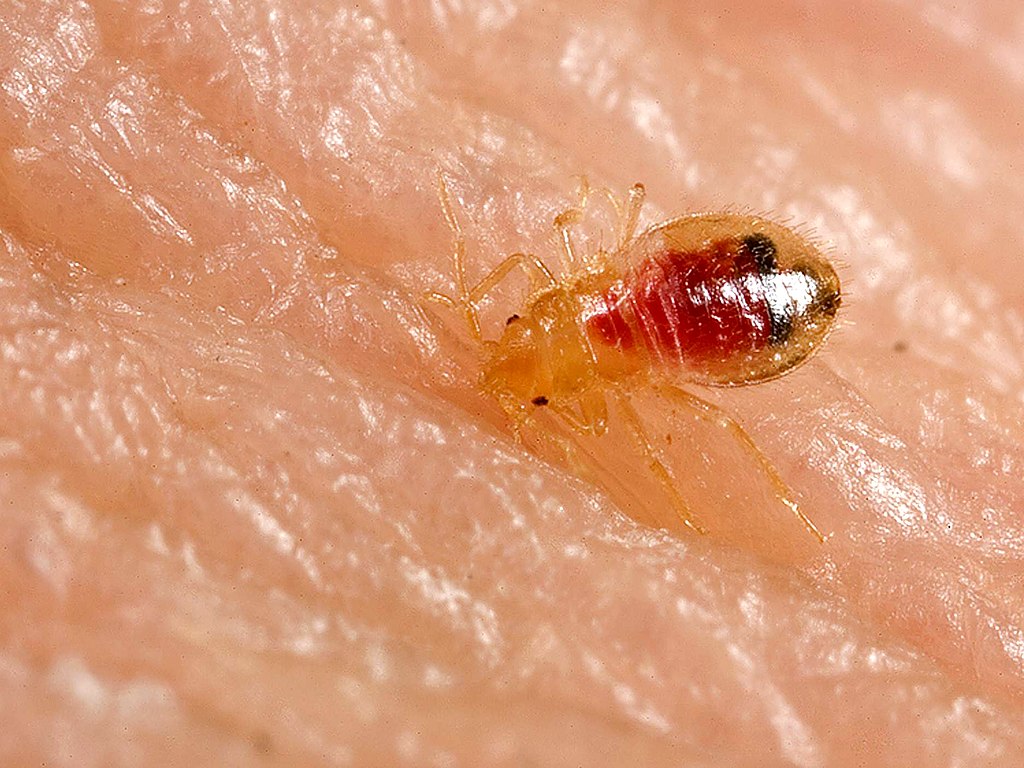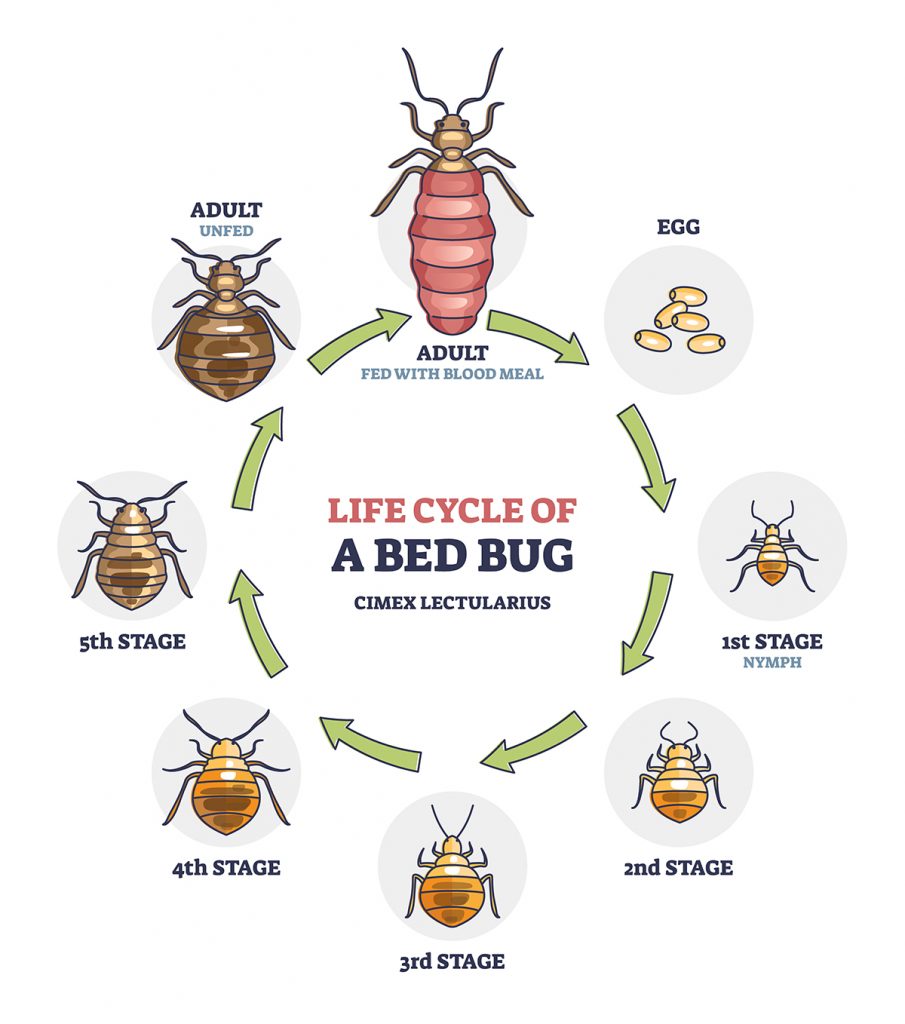Bed bugs might be tiny, but they can cause big headaches for homeowners and hospitality businesses alike. Spotting them early is key to avoiding a full-blown infestation. But what about baby bed bugs? Can you even see them? Here, we focus on bed bug babies and find out what to look for.
From egg to nymph: the start of the journey
Believe it or not, bed bugs don’t start life as the apple seed-sized pests we all know and loathe. They begin as eggs, and these are seriously small, like a grain of sand small.
Female bed bugs are prolific little egg-layers, capable of producing up to five eggs per day and around 500 in their lifetime. That’s a lot of potential for trouble. These eggs are usually laid in clusters in dark, hidden spots—think mattress seams, headboards or even behind wallpaper.
Once these minuscule eggs hatch, we get what’s commonly called a “baby” bed bug. But if you want to sound like a pest control pro, call them nymphs.
nymphs are transparent, which makes them very hard to see! Below is a close-up photo of a nymph enjoying a blood-meal.

The image above is close-up of a stage 1 nymph. But do you think you could spot a nymph crawling on a bed?
The video below shows an older nymph (stage 2 or 3) crawling on some bed sheets.
As you can see in the video, even at this early stage, bed bug nymphs are on the move. They’re small, but they’re mighty—and they’re after your blood.
Shedding and feeding
Bed bugs are like tiny vampires in training. They need to feed and grow through several stages before they reach adulthood. Each stage is marked by the bug shedding its skin, a process that sounds fancy when you call it ‘moulting’.

Caption: The life cycle of a bed bug (Cimex lectularius)
This diagram shows the full life cycle of a bed bug. From the tiny egg, through five nymph stages, to the adult bed bug, you can see how these pests develop over time.
Let’s break down these stages:
- Egg stage: As mentioned, these are tiny white ovals, about 1mm long. They’re usually laid in clusters and take about six to10 days to hatch.
- First nymph stage: Fresh out of the egg, these nymphs are about 1.5mm long and almost colourless. They’re hungry from the get-go and will seek out a blood meal as soon as possible.
- Second to fifth nymph stages: With each moult, the nymph grows larger and darker. By the fifth stage, they’re about 4.5mm long and have taken on a more reddish-brown colour.
- Adult stage: After the fifth moult, we’ve got a full-grown bed bug on our hands. They’re about five to seven mm long and mahogany brown in colour if they have been feeding, or a beige colour is they haven’t.
Each of these stages requires blood meals to progress to the next. Without food, they can’t grow up. That’s why they’re often found close to where humans sleep or rest for long periods.
What to look for: spotting the baby bed bugs
So, what should you be on the lookout for? Here’s a quick guide to baby bed bug spotting:
- Size: Newly hatched nymphs are about one mm long. That’s about the size of a pinhead. That’s small.
- Colour: They start off a see-through white-yellow colour, getting darker as they grow and feed. After a blood meal, they’ll appear bright red before digestion occurs.
- Shape: Even as babies, they’ve got that classic bed bug oval shape. They’re flat and broad, which helps them squeeze into tight spaces.
- Movement: These little ones are mobile from day one, actively seeking out their next meal (that’s you, by the way).
- Location: Check seams of mattresses, cracks in bed frames and other dark, hidden spots. They love to play hide and seek.
- Shed skins: As nymphs grow, they leave behind light-coloured, hollow exoskeletons. Finding these can be a sign of an active infestation.
- Faecal spots: Even young bed bugs leave behind dark, ink-like stains on fabrics and surfaces after feeding. These spots often look like someone’s dotted the area with a fine-tipped marker.
Why should you care?
If you’re in the hospitality industry, spotting baby bed bugs early can save you from a PR nightmare and potential loss of business. Nobody wants to stay in a hotel with bed bugs, no matter how posh it is. Regular, thorough inspections of guest rooms, especially of beds and upholstered furniture, can help catch infestations early.
For homeowners, catching these tiny invaders before they multiply can save you from a full-blown infestation that’s much harder (and more expensive) to treat. You don’t want to be dealing with a bed bug army. Be especially vigilant after travelling or bringing second-hand furniture into your home.
The rapid reproduction reality
Here’s a sobering thought: under ideal conditions, bed bugs can complete their life cycle from egg to adult in as little as a month. And remember, those 500 eggs a female can lay in her lifetime? In just six months, a few bed bugs can turn into an infestation of 13,000 or more. That’s not a typo—these things really can multiply that quickly.
This rapid reproduction rate is why early detection is so important. The sooner you spot and deal with bed bugs, the easier (and cheaper) it is to get rid of them.
What to do If you spot baby bed bugs
If you think you’ve seen baby bed bugs, don’t panic. But don’t ignore it either. Here’s what to do:
- Don’t try to tackle it yourself. Bed bugs are notoriously tricky to get rid of. Over-the-counter sprays might seem tempting, but they often just scatter the bugs, making the problem worse.
- Call in the professionals. They’ve got the tools and know-how to deal with these pests properly. They can also confirm whether you’re really dealing with bed bugs or another type of insect.
- If you’re in a hotel, report it to management immediately. Don’t just switch rooms. Bed bugs are excellent travellers and could have already spread.
- If you’re at home, start washing and drying all your bedding on high heat. It won’t solve the problem, but it can help contain it until the pros arrive. The heat from a dryer on high setting for at least 30 minutes can kill all life stages of bed bugs.
- Vacuum thoroughly. This includes all the cracks and crevices in furniture and along baseboards. Seal the vacuum bag in a plastic bag and dispose of it outside immediately.
- In the hospitality business? Have a clear protocol in place for staff to follow if they suspect bed bugs. Quick action can prevent a small problem from becoming a big one.
Canine alerts
While you can’t rely on this at home, professional pest control companies often use highly trained bed bug sniffer dogs. These clever canines can detect bed bugs at all life stages, even eggs. They’re particularly useful for finding those sneaky baby bed bugs that might be too small for the human eye to spot. If you’re in a hotel or large property, you might want to use these four-legged pest detectives to get to work. They’re like tiny, furry superheroes in the fight against bed bugs!
Summing up: fighting bed bugs of all shapes and sizes
When it comes to bed bugs—whether they’re babies or adults—early action is always best. Don’t let them take over your space. Stay vigilant, know what to look for, and don’t hesitate to call in the experts if you suspect an infestation.
Contact Merlin and get an instant quote to see how we can deal with your bed bug problems.

